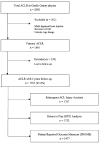Clinical Outcomes of Anterior Cruciate Ligament Reconstruction in Gaelic Games Players
- PMID: 40777576
- PMCID: PMC12329269
- DOI: 10.1177/23259671251352207
Clinical Outcomes of Anterior Cruciate Ligament Reconstruction in Gaelic Games Players
Abstract
Background: The Gaelic games, specifically Gaelic football, hurling, and camogie, are high-intensity, level 1 field sports. However, there is a lack of data regarding the outcomes of anterior cruciate ligament reconstruction (ACLR) in Gaelic games players.
Purpose: To evaluate the rates of return to play (RTP), ACL graft reinjury, contralateral ACL injury, and patient-reported outcome measures (PROMS) in a cohort of Gaelic footballers and hurling/camogie players at 2 years after ACLR.
Study design: Cohort study; Level of evidence, 2.
Methods: A consecutive cohort of 1891 Gaelic games players who underwent primary ACLR between 2014 and 2018 was included. Patients were contacted at 2 years postoperatively with an overall follow-up rate of 93.4%. The rate of RTP, subsequent ACL injury, and PROMS were recorded. The PROMS evaluated were the Marx score, the ACL-Return to Sport after Injury (ACL-RSI), and the International Knee Documentation Committee (IKDC) score.
Results: The mean age was 23 ± 6 years, and 73.3% of athletes were male. RTP rates were 87.8% for Gaelic football and 89.5% for hurling/camogie, with 72.7% and 76.3% of athletes returning to an equivalent or higher level of performance, respectively. Female Gaelic footballers had a slightly lower RTP rate than males (83.8% vs 89.1%; P < .016). The mean time to RTP was 10.8 ± 4 months. The rate of bone-patellar tendon-bone (BPTB) autograft reinjury was 3.3% (51/1547) versus 15.3% (33/216) for hamstring (HT) autografts (P < .001). Senior intercounty (elite) players had the lowest rate of contralateral ACL injury (8.1%, 14/173). Gaelic footballers and hurling/camogie players reported good outcomes with mean IKDC scores of 86.9 ± 9.8 versus 87.9 ± 8.9, (P = .064), mean Marx scores of 11 ± 4.7 versus 11.3 ± 4.6 (P = .309), and mean ACL-RSI scores of 74.1 ± 23.5 versus 75.8 ± 24.2 (P = .321), respectively.
Conclusion: RTP rates among Gaelic games players were high, with the majority returning to an equivalent/higher level of performance. The rate of BPTB graft reinjury was low, considering the injury risk associated with returning to level 1 sport. Younger patients and those who underwent HT autograft reconstruction were at the highest risk of ACL graft reinjury. Overall, Gaelic games players reported good knee function and outcomes after ACLR.
Keywords: Gaelic football; Gaelic games; anterior cruciate ligament; camogie; hurling; level 1 sport.
© The Author(s) 2025.
Conflict of interest statement
One or more of the authors has declared the following potential conflict of interest or source of funding: T.M. receives research funding under the Strategic Academic Recruitment (StAR) Programme of the Royal College of Surgeons Ireland. The content of this manuscript is solely the responsibility of the authors and was not influenced by the funding entity. AOSSM checks author disclosures against the Open Payments Database (OPD). AOSSM has not conducted an independent investigation on the OPD and disclaims any liability or responsibility relating thereto. Ethical approval for this study was obtained from the Sports Surgery Clinic (25-AFM-010).
Figures






Similar articles
-
Anterior Cruciate Ligament Tears in the Adolescent Population: Injury Demographics and Risk of Reinjury Among High School Athletes.J Pediatr Orthop. 2023 Nov-Dec 01;43(10):591-597. doi: 10.1097/BPO.0000000000002505. Epub 2023 Sep 20. J Pediatr Orthop. 2023. PMID: 37728131
-
Primary Anterior Cruciate Ligament Reconstruction in Level 1 Athletes: Factors Associated With Return to Play, Reinjury, and Knee Function at 5 Years of Follow-up.Am J Sports Med. 2025 Mar;53(4):777-790. doi: 10.1177/03635465241313386. Epub 2025 Feb 7. Am J Sports Med. 2025. PMID: 39919304
-
A Higher Thigh Muscle Injury Incidence in Professional Male Soccer Players Returning to Play After Anterior Cruciate Ligament Reconstruction: Analysis of 110 Cases From the UEFA Elite Club Injury Study.Am J Sports Med. 2025 Aug;53(10):2440-2446. doi: 10.1177/03635465251353213. Epub 2025 Jul 8. Am J Sports Med. 2025. PMID: 40624968
-
Return to Sport and Graft Failure Rates After Primary Anterior Cruciate Ligament Reconstruction With a Bone-Patellar Tendon-Bone Versus Hamstring Tendon Autograft: A Systematic Review and Meta-analysis.Am J Sports Med. 2025 Jul;53(8):1996-2006. doi: 10.1177/03635465241295713. Epub 2025 Jan 21. Am J Sports Med. 2025. PMID: 39836368
-
Clinical Outcomes After ACL Reconstruction in Soccer (Football, Futbol) Players: A Systematic Review and Meta-Analysis.Sports Health. 2023 Nov-Dec;15(6):788-804. doi: 10.1177/19417381231160167. Epub 2023 Mar 29. Sports Health. 2023. PMID: 36988238 Free PMC article.
References
-
- Ardern CL, Glasgow P, Schneiders A, et al. 2016 Consensus statement on return to sport from the First World Congress in Sports Physical Therapy, Bern. Br J Sports Med. 2016;50(14):853-864. - PubMed
-
- Ardern CL, Taylor NF, Feller JA, Webster KE. Fifty-five per cent return to competitive sport following anterior cruciate ligament reconstruction surgery: an updated systematic review and meta-analysis including aspects of physical functioning and contextual factors. Br J Sports Med. 2014;48(21):1543-1552. - PubMed
-
- Ardern CL, Webster KE, Taylor NF, Feller JA. Return to the preinjury level of competitive sport after anterior cruciate ligament reconstruction surgery: two-thirds of patients have not returned by 12 months after surgery. Am J Sports Med. 2011;39(3):538-543. - PubMed
-
- Beasley KJ. Nutrition and Gaelic football: review, recommendations, and future considerations. Int J Sport Nutr Exerc Metab. 2015;25(1):1-13. - PubMed
-
- Beischer S, Gustavsson L, Senorski EH, et al. Young athletes who return to sport before 9 months after anterior cruciate ligament reconstruction have a rate of new injury 7 times that of those who delay return. J Orthop Sports Phys Ther. 2020;50(2):83-90. - PubMed
LinkOut - more resources
Full Text Sources

